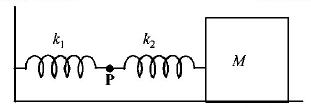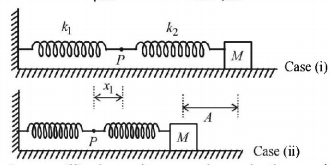Question
The mass $$M$$ shown in the figure oscillates in simple harmonic motion with amplitude $$A.$$ The amplitude of the point $$P$$ is
The mass $$M$$ shown in the figure oscillates in simple harmonic motion with amplitude $$A.$$ The amplitude of the point $$P$$ is

A.
$$\frac{{{k_1}A}}{{{k_2}}}$$
B.
$$\frac{{{k_2}A}}{{{k_1}}}$$
C.
$$\frac{{{k_1}A}}{{{k_1} + {k_2}}}$$
D.
$$\frac{{{k_2}A}}{{{k_1} + {k_2}}}$$
Answer :
$$\frac{{{k_2}A}}{{{k_1} + {k_2}}}$$
Solution :

In case (ii), the springs are shown in the maximum compressed position. If the spring of spring constant $${{k_1,}}$$ is compressed by $${{x_1}}$$ and that of spring constant $${{k_2}}$$ is compressed by $${{x_2}}$$ then
$$\eqalign{ & {x_1} + {x_2} = A\,......\,\left( {\text{i}} \right) \cr & {\text{and }}{k_1}{x_1} = {k_2}{x_2} \Rightarrow {x_2} = \frac{{{k_1}{x_1}}}{{{k_2}}}\,......\,\left( {{\text{ii}}} \right) \cr & {\text{From}}\left( {\text{i}} \right)\& \left( {{\text{ii}}} \right) \cr & {x_1} + \frac{{{k_1}{x_1}}}{{{k_2}}} = A \Rightarrow {x_1} = \frac{{{k_2}A}}{{{k_2} + {k_1}}} \cr} $$

In case (ii), the springs are shown in the maximum compressed position. If the spring of spring constant $${{k_1,}}$$ is compressed by $${{x_1}}$$ and that of spring constant $${{k_2}}$$ is compressed by $${{x_2}}$$ then
$$\eqalign{ & {x_1} + {x_2} = A\,......\,\left( {\text{i}} \right) \cr & {\text{and }}{k_1}{x_1} = {k_2}{x_2} \Rightarrow {x_2} = \frac{{{k_1}{x_1}}}{{{k_2}}}\,......\,\left( {{\text{ii}}} \right) \cr & {\text{From}}\left( {\text{i}} \right)\& \left( {{\text{ii}}} \right) \cr & {x_1} + \frac{{{k_1}{x_1}}}{{{k_2}}} = A \Rightarrow {x_1} = \frac{{{k_2}A}}{{{k_2} + {k_1}}} \cr} $$